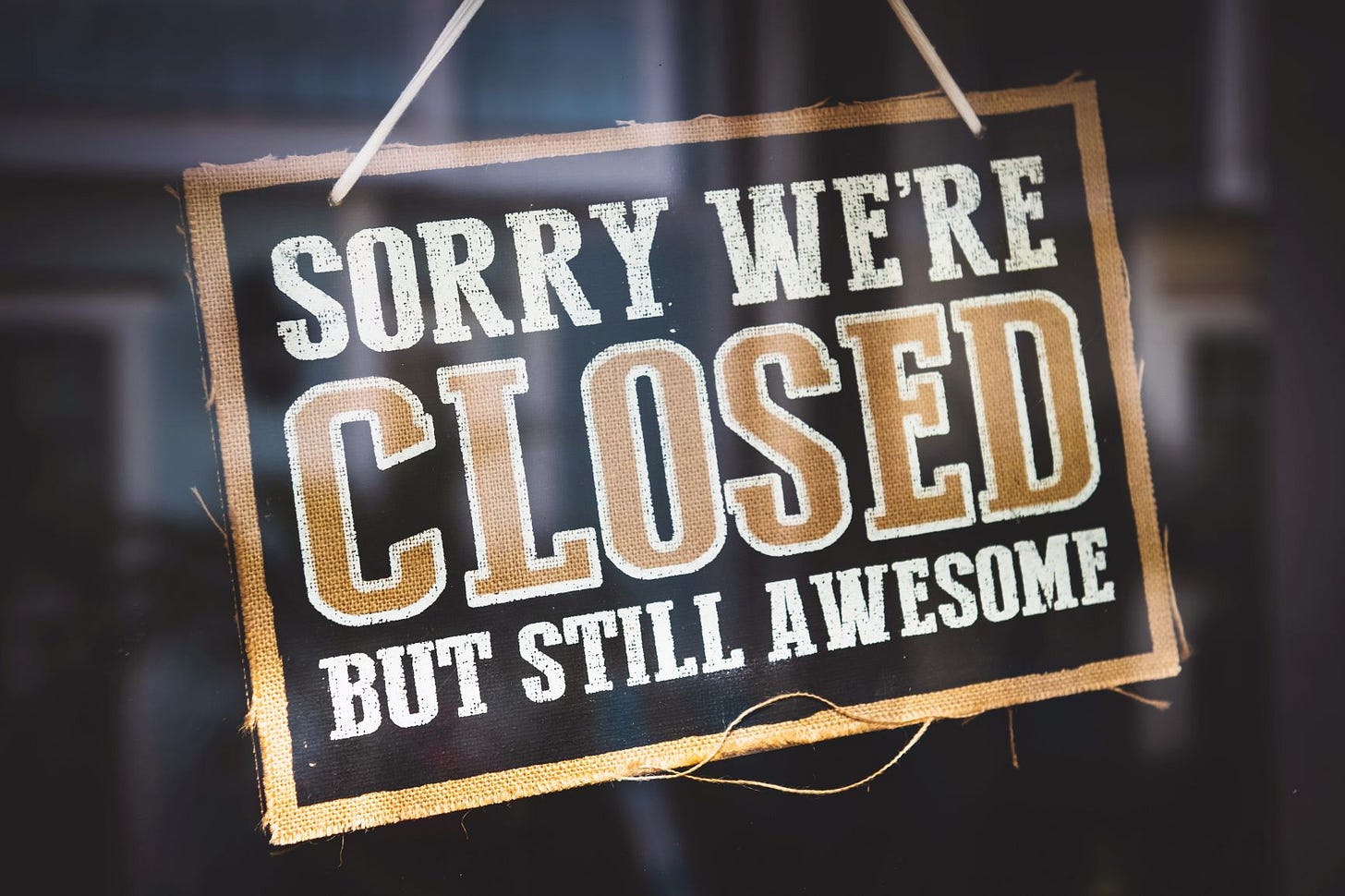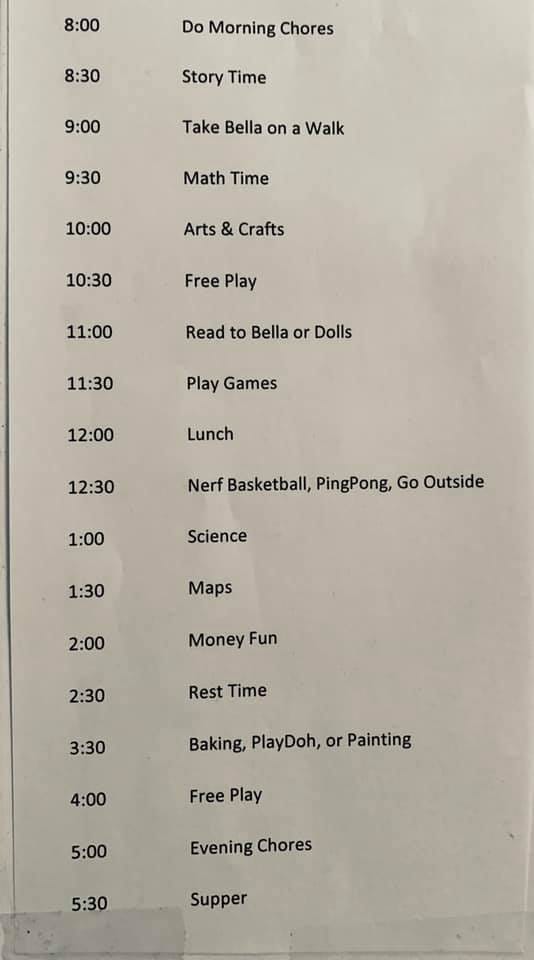The World Is Cancelled
Fortunately, the Weeklish continues, and you have a 0% chance of getting the Coronavirus from it.

Photo by Tim Mossholder on Unsplash [Image] signage that says “sorry we’re closed but still awesome”
Hey, Y’all!
I feel like I am living in an alternate universe.
This week started pretty unremarkably. My calendar was filled with visiting schools, supporting students, going to meetings, and doing paperwork.
By Wednesday afternoon, all of that had changed when someone at a school that I support tested positive for the Coronavirus. The district decided to close down the school for two weeks.
Skip to Thursday afternoon, and now numerous school districts across the country are closed for the foreseeable future.
What do we do now?
I had not planned to write about the Coronavirus this week, but since that is what is on everyone’s mind, I think it is important to pivot.
There is a good possibility that students with disabilities will be without direct instruction for weeks, if not months. So as educators and parents, we are going to have to figure out what to do with all that lost instructional time.
One small thing we can do, for those who are able, is to start making a schedule or routine to follow while our kids are home with us.
Last night, my wife and I sat with the family and brainstormed some ideas on projects that we could do as a family. We also discussed that the time away from school would not be a vacation and that they would still be expected to learn.
We also do this during summer vacation because without a schedule we are all likely to Netflix and chill the entire time.
So what does this look like for children with disabilities?
First, make a schedule. Whether or not you are able to be at home with your child, creating a predictable routine is essential.
One of my Facebook friends, an educator (and parent of a child who is disabled and medically fragile), posted this schedule.

My family is planning on doing something similar, even with “recess” time with the neighborhood. Your schedule can fit your family’s lifestyle as well as be age-appropriate for your kids.
Next, keep school bedtimes. Sure, staying up a little bit later and sleeping in is fine, but keeping to your routine is essential. Again, this is not vacation and it is probably a mistake to treat it that way.
Reach out to your child’s teacher. Chances are, your child’s teacher will be sending home or making digital materials and curriculum available to you.
If not, a great resource is your local library (they often have digital learning options).
A couple of resources that are offering free content or a free trial (that I am currently aware of) are BrainPop and N2Y. Also, there are tons of free resources on Teachers Pay Teachers. Don’t forget about more traditional online learning modules from Khan Academy or LearnZillion.
Finally, plan some special activities. As an educator, I know that planning engaging activities is tremendous for learning. And using a child’s interests or passions into the curriculum helps with the excitement for learning the content. What are your child’s special interests or passions? Do they love the Titanic? Perhaps try building a model from cardboard. Or looking up informational videos on YouTube or PBS.
Here is an excerpt from a post called, How to Prepare for Extended School Closings (And Not Lose Your Mind), that was shared with me from amothershipdown.com
FIND A WAY TO MAKE SOME SPECIAL MEMORIES
As weird as it sounds, there are actually some good opportunities here to make special memories with your kids.
We are in uncharted territory now. I’m almost certain that we will remember this time – and how we came together, or didn’t – decades from now. So do your best to find some way to create special moments.
Maybe every night the kids get to put special toppings on an ice cream scoop.
Maybe you all read together in a tent with a flashlight, to create a sense of adventure and camaraderie rather than fear.
Maybe you watch a movie together as a family each night, knowing you can sleep in a bit later (unless you have toddlers, in which case good luck sleeping later).
Maybe instead of a regular nightly bath it’s a bubble bath with glow sticks around the room.
You get the idea.
Kids love and appreciate magic, and anything that seems “special” or out of the ordinary. So do something to acknowledge that this time is different – and to allow a new, special tradition to take root in your child’s mind.
These are the things childhood memories are made of, and despite the fear many of us feel, we do have an opportunity here.
But what if my child needs a modified curriculum?
The most important thing you need to know about modifying any curriculum is that any standard for any grade can be modified by taking just one part of it and making it accessible to your student.
For example, if your child is in fourth grade and they are working on one-digit multiplication but they don’t have it quite yet, try using a multiplication chart or calculator. You can always look at your child’s accommodations in their Individualized Education Program to see how their teacher would help them access that standard or skill.
For reading, try looking up adapted book resources from Tar Heel Reader or the Paul V. Sherlock Center.
Need more? Look for an article from Noodle coming very soon.
An uncertain future
TBH, I am not sure what to expect. And as an educator, the students and families I serve are on my mind constantly.
I wish all of you the best, and I’m sending love to each and every one of you. We will get through this.
You can always email or reply to this post if you have questions or want to share a resource.
Thanks for your time and attention.
Tim
ICYMI
Noodle: The One Story Every Teacher Needs to Know (And Why)
Think Inclusive: What Is Special Education Advocacy and Why Do We Need It?
For our paid subscribers, look for my list of links coming soon. I decided to get the free edition of the newsletter out to you as soon as I could.



